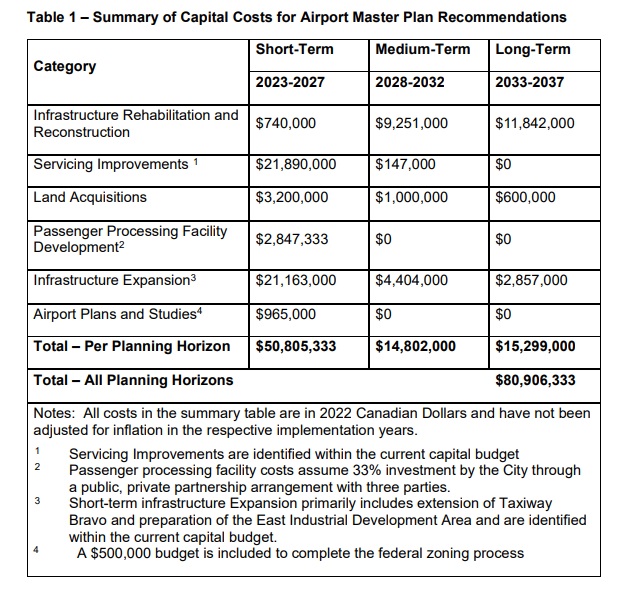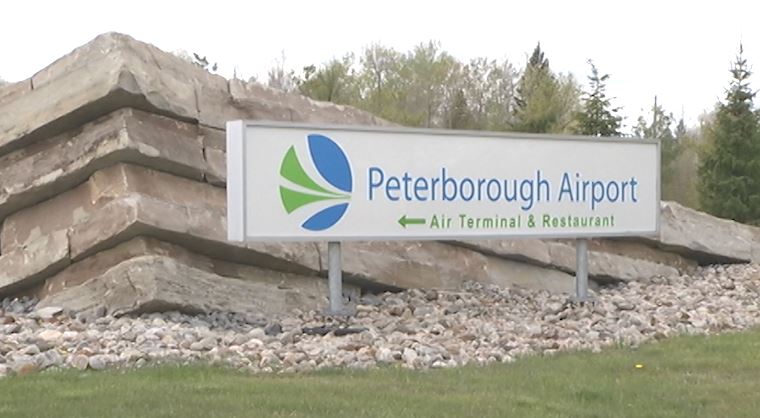A new staff report recommends Peterborough city council approve the Peterborough Airport Master Plan which would see more than $80 million in capital costs over a 15-year span.

On Monday, Peterborough city council will be asked to support the recommendations outline in an extensive report on the airport’s master plan by Jasbir Raina, the city’s Commissioner of Infrastructure and Planning Services.
In November 2021, council passed a motion to have the master plan updated since it was last updated in 2009. The new master plan would focus on development and growth from 2022 to 2037.
The estimated capital costs associated with the recommendations outlined in the master plan are approximately $80,956,333 over 15 years with short- and long-term investments, Raina notes. The recommendations focus on infrastructure, expansion, reconstruction, servicing improvements, land acquisitions and future studies.
The master plan aims to ensure the airport is “positioned to embrace new opportunities” while continuing to serve the city, region and aerospace industry, Raina says.
The report says as of 2022, it’s estimated the municipal airport contributes more than $90 million to the Gross Domestic Product (GDP) annually with an
estimated 507 positions directly employed by at least 20 businesses at the airport.
That’s up from $41 million in 2009, representing an annualized growth of approximately nine per cent.
Business strategies
Among key business strategies identified in the master plan over the 15-year timeframe include:

Get daily National news
- Expand passenger air services: Notably adding sun destination flights (16 per year to southern destinations such as Florida, Mexico, Caribbean) and specialized chartered services to select destinations.
- Expand passenger facility requirements: The current air terminal has a peak hourly capacity of 38 passengers, failing to adequately serve some flights that have had 130 passengers, the report states. The plan says to expand or build a new space for a capacity of 340 passengers.
- Aviation and aerospace: Continue to grow aerospace support, education, research and development opportunities at the airport and region.
- Support further flight training growth.
- Improving the primary runway by widening. However, the report notes due to surrounding wetlands and ground conditions, there are “development constraints” and a “relatively limited area” for future development.
- Land acquisitions to expand including extension of the Taxiway Bravo runway. The project may include acquisition of nearby properties.
- Improve technologies and aging infrastructure such as water and sewer, improvements to fire regulation requirements, add a new pump-house generator
- Additional airport plans and studies.

The report notes future city councils will approve and determine timelines for projects.
Raina says the Peterborough Airport is one of the 11 airports with the Southern Ontario Airport Network, representing 55,300 jobs across the network.
“The population of Southern Ontario in 2043 is expected to reach 15.5 million with a total of $1 trillion of GDP. Regional growth is expected to drive aviation
demand in Southern Ontario,” the report states.
Among notable investments over the past decade include:
- $21M in 2010 from all levels of government to expand the runway to 7,000 feet from 5,000, build a new terminal and prepare lots for commercial and private development.
- $6 million capital investment from the city to facilitate the relocation of Seneca College from Buttonville Airport; involving the partial extension of Taxiway Bravo — a new 2,000 foot-long crosswind runway with a parallel taxiway — and a private aircraft parking apron.
The report says more than 80 stakeholders representing 38 organizations and municipalities provided input on the master plan.
“The plan has identified business development and growth strategies that include a supporting capital plan to position the airport for continued growth with
passenger service being a new focus and key pillar in sustainable revenue generation,” Raina concludes. ” As a result of the restricted timeline of the study, further studies and analysis are recommended to further define and prioritize the identified capital requirements.”












Comments